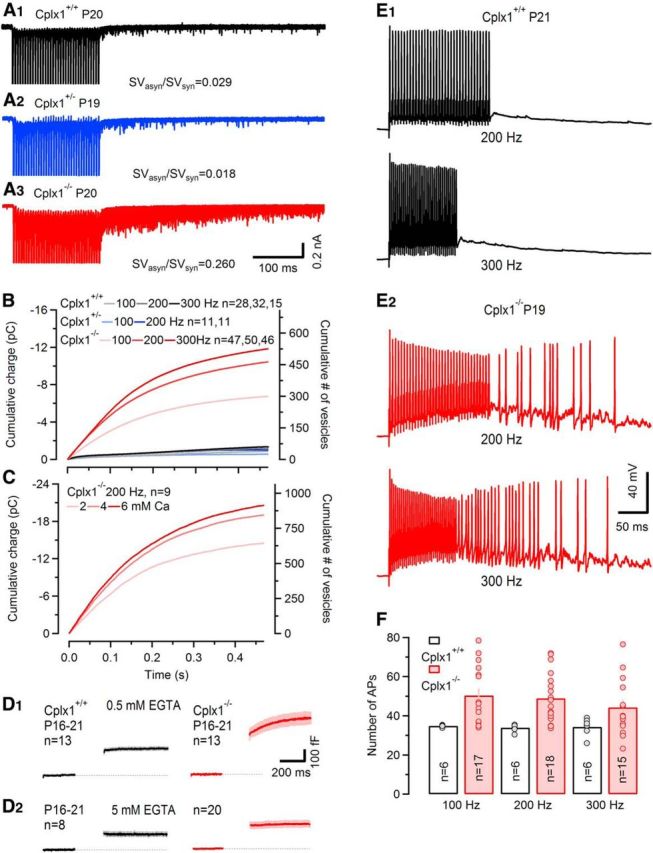Figure 7.

Strongly enhanced asynchronous release in P16–P21 Cplx1−/− synapses promotes aberrant postsynaptic AP firing. A, Ten consecutive traces of 200 Hz trains consisting of 35 EPSCs evoked by afferent-fiber stimulation and recorded in a P20 Cplx1+/+ (black), a P19 Cplx1+/− (blue), and a P20 Cplx1−/− (red) calyx synapse are shown superimposed. Amplitudes of AP-evoked synchronous EPSCs are truncated. Note the strongly enhanced asynchronous release during the first 500 ms following the stimulus trains in the Cplx1−/− synapse. B, Average cumulative charge of asynchronously released quanta plotted versus time after the end of stimulation for different stimulus frequencies (100, 200, and 300 Hz) for Cplx1+/+ (gray and black), heterozygous Cplx1+/− (blue), and Cplx1−/− (red) synapses. Cumulative charge of asynchronous release was obtained by integration after subtracting an exponential fit to the baseline to take into account a small current component activated by residual glutamate. C, Average cumulative charge of asynchronous release after 200 Hz trains plotted versus time for recordings in normal (2 mm) and elevated (4 and 6 mm) external [Ca2+]. Elevating external [Ca2+] further augmented asynchronous release in Cplx1−/− synapses. D, SV exocytosis after stimulus trains assayed by presynaptic membrane capacitance measurements. Stimulus trains consisted of 35 steps (1 ms from Vh = −80 to 0 mV) at a frequency of 200 Hz. Average ΔCm traces are shown. Number of terminals tested as indicated. D1, In the presence of 0.5 mm EGTA, Cplx1−/− synapses (red) showed ongoing delayed SV fusion after train stimulation. Delayed SV fusion was nearly undetectable in Cplx1+/+ terminals (black). D2, With 5 mm EGTA in the pipette solution, delayed release in Cplx1−/− mice was suppressed. E, 200 Hz (top) and 300 Hz (bottom) postsynaptic AP trains elicited by afferent fiber stimulation and recorded in a Cplx1+/+ (E1) and a Cplx1−/− (E2) MNTB PN in current-clamp mode. Whereas wt synapses generally followed presynaptic stimulation faithfully, Cplx1−/− neurons generated numerous aberrant spikes during and/or following the stimulus trains. F, Average numbers of APs elicited by high-frequency stimulus trains (100, 200, and 300 Hz, 35 stimuli) obtained from wt (black) and Cplx1−/− (red) synapses. Number of cells recorded as indicated. Average numbers of APs in Cplx1+/+ MNTB PNs were 35, 34, and 34 for 100, 200, and 300 Hz, respectively, whereas Cplx1−/− PNs fired on average >44 postsynaptic APs for any of these frequencies.
